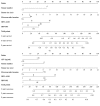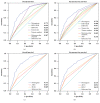HBV-DNA Load-Related Peritumoral Inflammation and ALBI Scores Predict HBV Associated Hepatocellular Carcinoma Prognosis after Curative Resection
- PMID: 30327670
- PMCID: PMC6171205
- DOI: 10.1155/2018/9289421
HBV-DNA Load-Related Peritumoral Inflammation and ALBI Scores Predict HBV Associated Hepatocellular Carcinoma Prognosis after Curative Resection
Abstract
Background: Both persistent inflammatory activity and liver function damage contribute to a poor prognosis of hepatocellular carcinoma (HCC). This study aimed to develop nomograms that incorporate hepatitis virus B (HBV)-related peritumoral inflammation score (PIS) and liver function based on ALBI score to predict postoperative outcomes of HCC.
Methods: The prognostic roles of HBV-related preoperative PIS and ALBI scores in HCC recurrence were examined, and then two nomograms were constructed. The predictive accuracy and discriminative ability of the nomograms were compared with AJCC and BCLC staging systems of HCC.
Results: PIS (HBV-PIS) and ALBI scores (HBV-ALBI) with different HBV-DNA loads had association with overall survival (OS) and/or recurrence-free survival (RFS) of HCC. The independent predictors of OS and RFS were incorporated into the corresponding nomograms. In the training cohort, the C-indexes of OS and RFS nomograms were 0.751 and 0.736, respectively. ROC analyses showed that both OS and RFS nomograms had larger AUC (0.775 and 0.739, respectively) than AJCC and BCLC staging systems. These results were verified by the internal and external validation cohorts.
Conclusion: The proposed nomograms, including HBV-DNA load-related PIS and ALBI scores, were accurate in predicting survival for HCC after curative resection.
Figures




References
LinkOut - more resources
Full Text Sources

